In arcade gaming, the 80’s were the decade of space shooters. The first video games often featured space settings, and gameplay mechanics that involved controlling a spacecraft of some type, and blasting your way through hordes of pixels arranged to resemble aliens with hostile intent.

It almost seems like, in the time where space travel was still in diapers, the public’s imagination was lit by the “Space Race” of the 50s & 60s, culminating with the moon landings of the early 70s. With films like Star Wars building on that hype in 1977, many video arcade games would incorporate outer space elements into their gameplay. Nowadays, we have the International Space Station, where researchers and trained individuals come and go, and space exploration is somewhat more commonplace than it was a couple of decades ago. For humankind, outer space still has a lot of unresolved mysteries, but we now know more than what we did a few years ago; it’s no longer a stuff of science fiction, and we have obtained valuable amounts of information from our travels to the “final frontier”. Consequently, newer space games have settings that are rooted in reality, or in the realm of plausibility, with the fantasy of the games of olden times all but gone.
That’s what we love about arcade games; arguably, the best games of this medium were released either in the 80’s or 90’s, with newer games improving on the formulae of their predecessors. Gaming in those decades was mired with wonder and magic. Every game was an adventure, and every “game over” was a prompt to begin anew and to keep on exploring the mysteries of your favorite arcade cabinets. There was no internet where people could Google all the secrets of a game before even experiencing them, and gamer guides were fairly rare to come across as a way to hold your hand throughout the process. The progress you made was solely on you, and the things you would discover on your adventures would make for great experiences. At the very least, the things you discovered would make for great stories, which you could share with like-minded friends, who would listen, intently and starry-eyed, and eagerly waiting until school’s out, so they could run over to the local arcade and keep on gamin’ the afternoon away.

But that’s enough nostalgia for now; these trips through memory lane are fun and all, but there’s work to be done. If you were a gamer in the 80’s, you knew from experience that the space theme was fairly commonplace. If you take a look at the Atari 2600’s game library and count the games that had the words “space” or “star” in their title, you’d need to use all your fingers and toes, and still need some extra hands and feet in order to count them all; and on arcade there wasn’t much of a difference. So, in the spirit of presenting you with the best games, here are 5 great space arcade titles you’ll surely enjoy (if you haven’t already).
Space Invaders
What better way to start this list, than with a classic that has been in the hearts and minds of arcade goers ever since its inception? Space Invaders was first developed in Japan by Taito, and licensed for production stateside by Midway. Released in 1978, this game singlehandedly launched arcade gaming from a niche and geeky pastime, all the way to mainstream culture to be enjoyed by everyone with a hankering for good gaming.
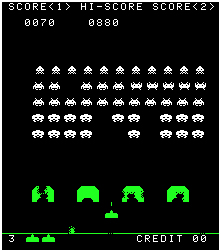
The gameplay was simple, yet effective; the player took control of a laser cannon that was relegated to the bottom of the screen, and that could shift left or right. The top half of the playing field was occupied by an army of alien enemies – or space invaders, if you will – who would also shift left and right while also slowly creeping towards the player. The objective was to control the cannon and shoot down the most waves of enemy ships possible. Some recent adaptations of the game have each wave on a timer and, as the player takes too long, the aliens start moving faster until they are defeated. Regardless, each new wave is inherently harder than the last. In order to add some layer of strategy to the game, the players have 4 defensive bunkers just above the cannon, which can be used as refuge from enemy fire. These bunkers will eventually chip away and disappear after taking a certain amount of damage, so the player needs to have a good balance of defense and offense in order to succeed.
Extra lives are awarded to the player every 1,000 to 1,500 points. The original game could only keep score until 9,990 points. After that, he could technically still keep playing, but his score would be maxed at the aforementioned amount.
Galaga
This one was also a favorite classic from the golden era of arcade games back in the early 80’s. Developed by Namco, and released to the public in 1981, Galaga combined the gameplay elements of Space Invaders, and added fast-paced and precision shooting elements to the mix, with a healthy dose of improved enemy behavior to boot.
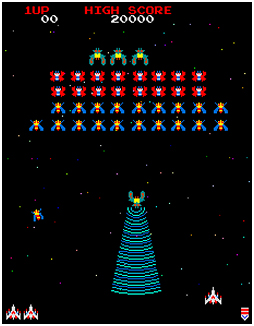
Like space Invaders, Galaga puts the player in the role of a fighter which was firmly planted on the bottom of the screen, only this time it’s a starship, instead of a mobile cannon. The enemies would swarm from the top in several formations, in an attempt to shoot, crash into, or capture the player’s ship. Galaga plays faster than Space Invaders, and has several distinct gameplay mechanics than its predecessor. For example, there are special “boss” enemies who could capture the player’s fighter and add it to its formation. The player could then destroy the boss, and add the recaptured ship to his formation, effectively doubling his firepower, with the tradeoff of being a bigger target. Furthermore, the enemies could assume formations in order to confuse, mislead, and potentially crash or shoot the player if he should slip and make a mistake.
Unlike Space Invaders, Galaga doesn’t require the player to destroy every single ship in each wave; as long as he is able to survive until the end, the stage is effectively cleared. However, significant bonuses are awarded for precision shooting, as well as for destroying every single enemy in a stage.
Though Galaga doesn’t have any type of limitations when it comes to keeping scores, there is a bug in the game that, when the players manages to beat stage 255, the counter would roll over to 0, and the game would stall, effectively ending the game, as progress would be impossible from that point on.
Defender
This is the first horizontal space shoot em’ up on the list. Defender was one of the most successful and profitable games of the golden era, selling over 55,000 units. This game was developed by Eugene Jarvis for Williams Electronics in 1981, and was the company’s highest-grossing game ever. Defenders was universally lauded for its cutting-edge visuals and audio, as well as for its unique gameplay and, to a lesser extent, for its merciless difficulty, which posed an adequate challenge for the most hardcore gamers.
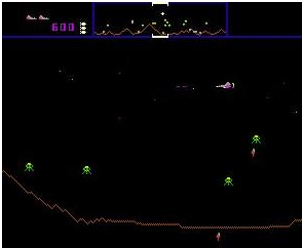
Truth be told, Defender was not the first game to use the horizontal scrolling formula, as there are a couple that came before. However, its success singlehandedly transformed the formula into its own unique genre, which in turn spawned some of the video game industry’s best hits, such as Life Force, Gradius, Macross, and so on.
Defender puts the player behind the stick of yet another spaceship. Gameplay consisted of navigating across a series of side-scrolling levels – from left to right, or viceversa – and shooting as many enemies as possible. The joystick is used to control the ship’s elevation, while the other 5 buttons could be used to control the ship’s horizontal direction, as well as its weapons. The objective was to destroy every single alien, and protect the astronauts, that were on the surface of the unnamed planet, from abduction. If an astronaut was captured by the aliens, he would return later as a mutant and attack the player. If all astronauts were captured, the planet would be overrun by aliens, and eventually explode, marking the end of the game. On the other hand, if all enemies were successfully dispatched, the planet would be restored to all its glory.
The player is initially assigned 3 ships to complete the mission, but could earn more by achieving certain scoring benchmarks
Star Wars
Back in the 80’s, the Star Wars Franchise was all the rage. The hype that Lucasfilms managed to attract with the first Star Wars movie, Episode IV: A New Hope, back in the late 70’s. Said hype managed to seep into the 80’s with its 2 sequels, The Empire Strikes Back, and Return of the Jedi, in 1980 and 1983, respectively. Due to the franchise’s popular acclaim, it was only logical that it would receive tons of adaptations, including an opening in the video game industry. This spot was filled by Atari and its 1983 Star Wars game, which put the player – quite literally – in the seat of Luke Skywalker’s X-Wing (designated as Red Five) and tasked him with dispatching the Empire’s forces throughout a series of stages.
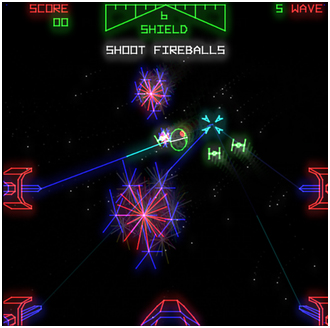
The game is played from a first person perspective (you could only see the ship’s nose and its 4 cannons), and made use of vector graphics in order to create its visuals. Like Galaga, the player didn’t have to destroy every single enemy; if he managed to survive until the end of the stage, it would still count as cleared. In Star Wars, a single hit didn’t mean death, instead, the player had a “shield” bar, which represents the amount of protection the ship had. The shield could take up to 6 hits and, after fading completely, an extra hit would mean a game over.
The game takes place on the Death Star as well as the air space around it, and was divided into 3 stages. The first consisted of a dogfight against Darth Vader and his lackeys, all on board their TIE Fighters, with the Death Star in the distance. The second stage was on the surface of the Death Star, where the player has to destroy the space station’s Flak Bunkers. In the third stage, the player would have to navigate throughout the Death Star’s trench in order to shoot a photon torpedo into the exhaust port, which would create a chain reaction, destroying the entire station.
After the third stage, the game would cycle back into the first stage, with increased difficulty. The player could continue to play until he is finally defeated, and his final score is tallied up for everyone to see.
R-Type
Somewhat like Defender, R-Type is also a horizontal shoot ‘em up but the scene only moves in one direction. Released in 1987 by Irem, this game takes Defender’s legacy and completely improves upon it with lots of features, as well as a more futuristic setting. Set in the 22nd century, the player must control the cutting-edge R-9a “Arrowhead” fighter ship and direct its vast arsenal and combat capabilities against the evil Bydo Empire.
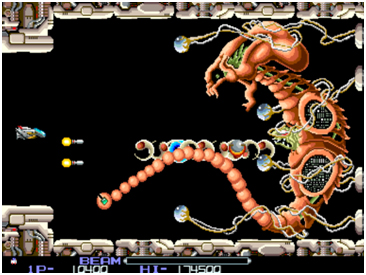
The player must traverse a series of levels, each with a unique boss at the end. Like Defender, the ship can maneuver both vertically and horizontally across the side-scrolling stages. The player must brave each level’s harsh environment, as well as the throngs of enemies tasked with destroying his ship.
R-Type was very ambitious for its time, mostly due to its programming, which accounted for ship power-ups, as well as various elements to make the gameplay more dynamic than its predecessors. In the beginning, the player is equipped with 2 cannons; a weak but rapid-firing chain gun, and a stronger beam cannon which required the player to hold down the button to charge up energy, and then release it in a focused beam that could pierce large enemies, as well as make short work of waves of small hostiles.
Furthermore, the player could obtain an auxiliary device called The Force. This device resembles an orange sphere and, upon obtaining it, granted the player a wider arsenal of weapons, as well as various other functions. The Force could be used either by attaching it to the ship, or by detaching it and letting it float freely alongside the player’s ship. While attached, The Force provides one of three powerful weapons, and can also serve as a ram to crash into enemies, given that the device is completely immune to enemy contact, and can dish out considerable damage to enemies on touch itself. When detached, The Force has access to three different sets of weapons, which can be remotely controlled by the player regardless of the distance between the Arrowhead and The Force.
The combination of power-ups, challenging stages, and the ability to control both The Force, as well as the R-9a gave R-Type a unique learning which holds up even with today’s standards of gaming.
So there you have it, 5 of the best space-themed games available on the arcade. Which ones are your favorites? Leave a comment down below and share your personal top 5!
Here at PrimeTime Amusements, we are on top of providing the very best arcade game sales and rental solutions on the market. Are you looking for an amusement in particular for your gaming room? then let us help you. If you want to place an inquiry with our team of agents, feel free to call us at 1.800.550.0090, or to visit us at 5300 Powerline Rd. Suite 210, Ft. Lauderdale, Florida, 33309.





